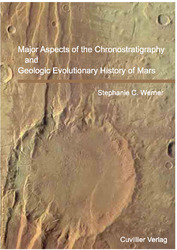| Fachbereiche | |
|---|---|
| Buchreihen (96) |
1378
|
| Nachhaltigkeit |
3
|
| Gesundheitswesen |
1
|
| Geisteswissenschaften |
2364
|
| Naturwissenschaften |
5406
|
| Mathematik | 229 |
| Informatik | 319 |
| Physik | 980 |
| Chemie | 1363 |
| Geowissenschaften | 131 |
| Humanmedizin | 243 |
| Zahn-, Mund- und Kieferheilkunde | 10 |
| Veterinärmedizin | 108 |
| Pharmazie | 147 |
| Biologie | 835 |
| Biochemie, Molekularbiologie, Gentechnologie | 121 |
| Biophysik | 25 |
| Ernährungs- und Haushaltswissenschaften | 45 |
| Land- und Agrarwissenschaften | 1004 |
| Forstwissenschaften | 201 |
| Gartenbauwissenschaft | 20 |
| Umweltforschung, Ökologie und Landespflege | 148 |
| Ingenieurwissenschaften |
1792
|
| Allgemein |
98
|
|
Leitlinien Unfallchirurgie
5. Auflage bestellen |
|
Erweiterte Suche
Major Aspects of the Chronostratigraphy and Geologic Evolutionary History of Mars
Stephanie C. Werner (Autor)Vorschau
Inhaltsverzeichnis, Datei (41 KB)
Leseprobe, Datei (100 KB)
This thesis was conducted in the framework of the German Research Foundation’s priority program Mars and the Terrestrial Planets as part of the project Chronostratigraphy of Mars. All global stratigraphic and geologic systems for Mars have been based on remote sensing data gathered during the Mariner 9 and Viking mission (Tanaka, 1986; Tanaka et al., 1992a), culminating in three 1:15M–scale geologic maps by Scott and Tanaka (1986); Greeley and Guest (1987); Tanaka and Scott (1987). Generally, most of the surface–forming processes were placed in the early phase of the Martian evolution. Chrono–stratigraphic schemes for Mars are derived from imagery and crater frequencies observed during Mariner 9 and Viking missions, and however, led to a wide range of chronologic systems with no clear consensus on the absolute ages (Hartmann, 1973b; Soderblom et al., 1974; Neukum and Wise, 1976; Hartmann et al., 1981; Neukum and Hiller, 1981; Neukum, 1983; Strom et al., 1992). Missions launched in the late 1990ies, such as Mars Global Surveyor and Mars Odyssey revealed very young volcanic surfaces, correlating in age with Martian meteorite crystallization ages (Hartmann, 1999a). Additionally, global topography (Smith et al., 1999a,b, Mars Orbiter Laser Altimeter) and gravity data (Zuber et al., 2000) as well as the discovery of strong remnant magnetization of the older Martian crust (Acu˜na et al., 1999), implied a more continual and diverse evolution than previously thought.
| ISBN-13 (Printausgabe) | 3865377742 |
| ISBN-13 (Printausgabe) | 9783865377746 |
| ISBN-13 (E-Book) | 9783736917743 |
| Sprache | Englisch |
| Seitenanzahl | 256 |
| Auflage | 1 |
| Band | 0 |
| Erscheinungsort | Göttingen |
| Promotionsort | Berlin |
| Erscheinungsdatum | 08.12.2005 |
| Allgemeine Einordnung | Dissertation |
| Fachbereiche |
Geowissenschaften
|








